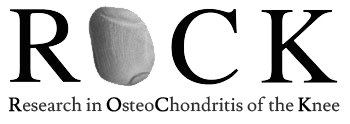[hr]
The Diagnosis and Treatment of Osteochondritis Dissecans
Summary of Recommendations
The following is a summary of the recommendations in the AAOS’ clinical practice guideline, The Diagnosis and Treatment of Osteochondritis Dissecans (OCD) of the Knee. The scope of this guideline is specifically limited to Osteochondritis Dissecans of the Knee. This summary does not contain rationales that explain how and why these recommendations were developed nor does it contain the evidence supporting these recommendations. All readers of this summary are strongly urged to consult the full guideline and evidence report for this information. We are confident that those who read the full guideline and evidence report will also see that the recommendations were developed using systematic evidence-based processes designed to combat bias, enhance transparency, and promote reproducibility. This summary of recommendations is not intended to stand alone. Treatment decisions should be made in light of all circumstances presented by the patient. Treatments and procedures applicable to the individual patient rely on mutual communication between patient, physician and other healthcare practitioners.
1. In a patient with knee symptoms (pain, swelling, locking, catching, popping, giving way) and/or signs (tenderness, effusion, loss of motion, crepitus), x-rays (including AP, lateral, sunrise/Merchant, and tunnel views) are an option.
Strength of Recommendation: Weak*
*To see the description of the evidence linked to the strength of the recommendations, please refer to Table 1; “Strength of Recommendation descriptions” in the guideline.
2. We are unable to recommend for or against x-rays on the contralateral asymptomatic knee in patients with confirmed OCD of one knee.
Strength of Recommendation: Inconclusive
3. In a patient with a known OCD lesion on x-ray, an MRI of the knee is an option to characterize the OCD lesion or when concomitant knee pathology is suspected such as meniscal pathology, ACL injury, or articular cartilage injury.
Strength of Recommendation: Weak
4. We are unable to recommend for or against non-operative treatment (casting, bracing, splinting, unloader brace, electrical or ultrasound bone stimulators, or activity restriction alone) for asymptomatic skeletally immature patients with OCD.
Strength of Recommendation: Inconclusive
5. We are unable to recommend for or against a specific non-operative treatment (casting, bracing, splinting, unloader brace, electrical or ultrasound bone stimulators, or activity restriction alone) for symptomatic skeletally immature patients with OCD.
Strength of Recommendation: Inconclusive
6. We are unable to recommend for or against arthroscopic drilling in symptomatic skeletally immature patients with a stable lesion(s) who have failed to heal with non operative treatment for at least three months.
Strength of Recommendation: Inconclusive
7. In the absence of reliable evidence, it is the opinion of the work group that symptomatic skeletally immature patients with salvageable unstable or displaced OCD lesions be offered the option of surgery.
Strength of Recommendation: Consensus
8. We are unable to recommend for or against a specific cartilage repair technique in symptomatic skeletally immature patients with unsalvageable fragment.
Strength of Recommendation: Inconclusive
9. We are unable to recommend for or against repeat MRI for asymptomatic skeletally mature patients.
Strength of Recommendation: Inconclusive
10. We are unable to recommend for or against treating asymptomatic skeletally mature patients with OCD progression (as identified by X-ray or MRI) like symptomatic patients.
Strength of Recommendation: Inconclusive
11. In the absence of reliable evidence, it is the opinion of the work group that symptomaticskeletally mature patients with salvageable unstable or displaced OCD lesions be offered the option of surgery.
Strength of Recommendation: Consensus
12. We are unable to recommend for or against a specific cartilage repair technique in symptomatic skeletally mature patients with an unsalvageable OCD lesions.
Strength of Recommendation: Inconclusive
13. In the absence of reliable evidence, it is the opinion of the work group that patients who remain symptomatic after treatment for OCD have a history and physical examination, x-rays and/or MRI to assess healing.
Strength of Recommendation: Consensus
14. We are unable to recommend for or against physical therapy for patients with OCD treated non-operatively.
Strength of Recommendation: Inconclusive

